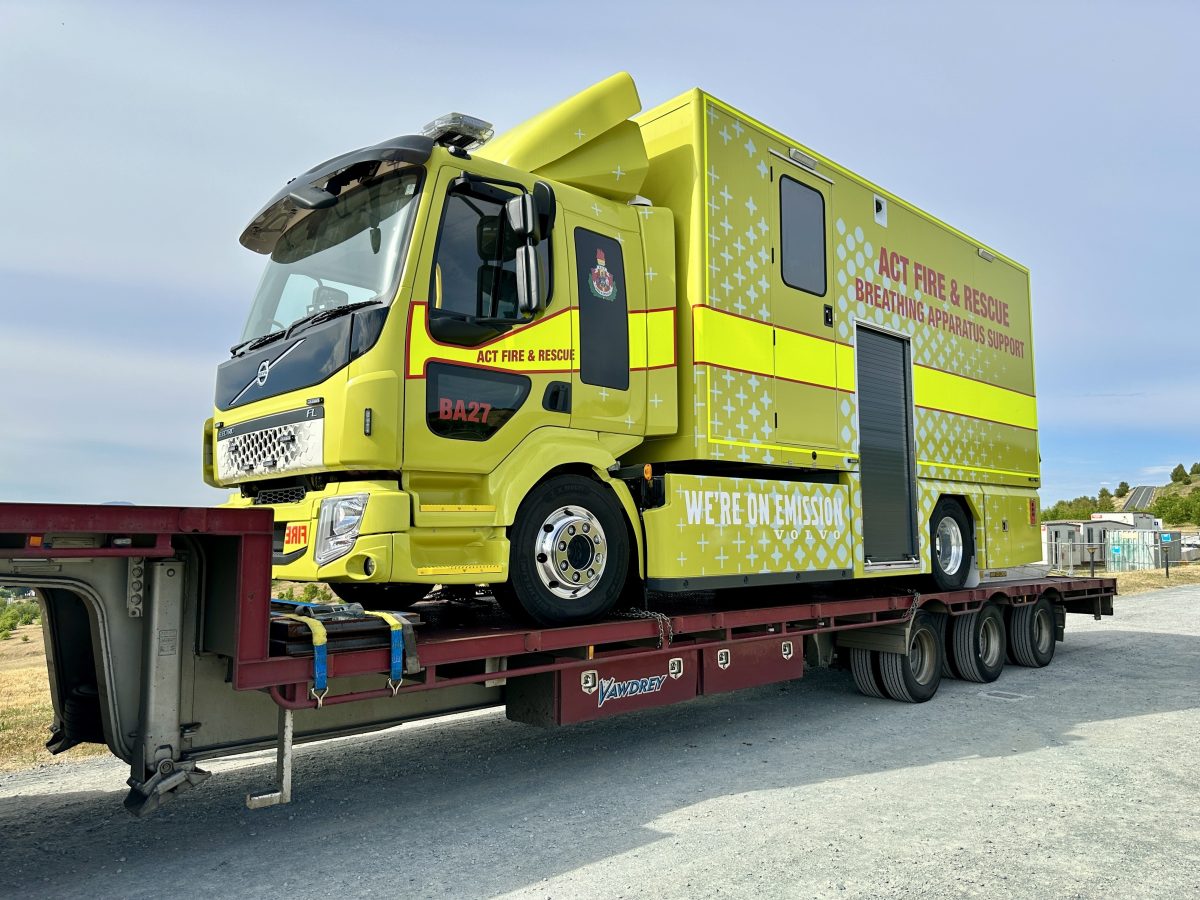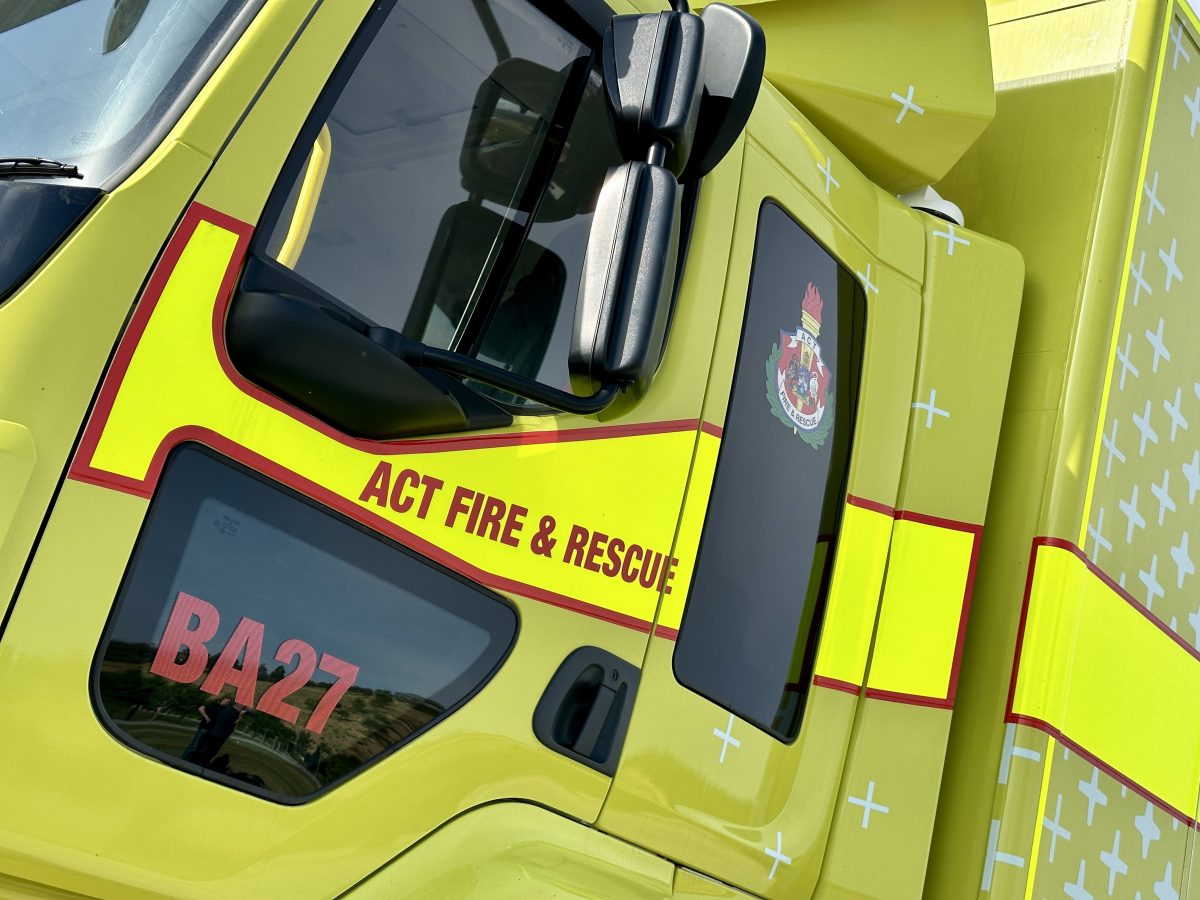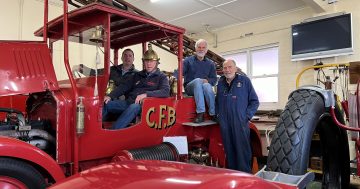
The new ACT Fire & Rescue truck arrives in Canberra on Wednesday, 8 November, on the back of an electric Volvo prime-mover. Photo: James Coleman.
Here’s a fire truck you won’t hear coming.
The Volvo FL Electric was first unveiled at August’s Australasian Fire and Authorities conference in Brisbane. Transported down to Canberra on the back of an electric Volvo prime-mover this week, it becomes the first fully electric truck in the ACT Fire & Rescue fleet.
When it starts work next year, it will replace an ageing diesel-powered support vehicle, tasked with providing specialist breathing apparatus at incidents including structure fires and hazardous material spills.
Minister for Police and Emergency Services Mick Gentleman said the truck was the first of four new electric emergency services vehicles delivered as part of a $12.7 million deal with Volvo Australia.
These will help the Emergency Services Agency (ESA) reach the emission targets set for it by the ACT Government – down 33 per cent by 2025, 66 per cent by 2030 and 100 per cent by 2045.
“When we look at the challenge in front of us, we have something like 300 vehicles in the ESA fleet that need to be replaced so we can meet that net-zero emissions target by 2045,” Mr Gentleman said.
“If we can reduce the amount of diesel particulates produced by our vehicles … then we’re actually assisting our people.”

ACT Fire & Rescue (ACTF&R) Superintendent for Capability Support Glenn Brewer, Volvo Australia vice president of Emerging Technology Paul Illmer, ACT Minister for Police and Emergency Services Mick Gentleman, and Embassy of Sweden Head of Mission Per Linneand. Photo: James Coleman.
ACT Fire & Rescue (ACTF&R) Superintendent for Capability Support Glenn Brewer described the truck as a “nimble vehicle designed for urban environments”.
“It will provide specialist breathing apparatus capabilities at a range of operations such as structure fires, hazardous materials, chemical, biological and nuclear incidents.”
In June, ACTF&R also welcomed the world’s first right-hand-drive plug-in hybrid pumper into the fleet, a $1.5 Rosenbauer.
However, this faced criticism from the ACT Auditor-General, who found the ESA “did not adequately assess the value for money of the vehicle prior to ordering it” and described the procurement process as “poorly conducted”.
The ESA responded with plans to “complete and implement a comprehensive evaluation plan and training plan” before the pumper started work early next year.
Minister Gentleman and Mr Brewer agreed this electric truck was different.
“Our frontline people have been involved from the very start in the way we procure these vehicles and design them so we can have those best outcomes for the responders on the ground,” Mr Gentleman said.
While the initial price was steep, he said lower running costs would make up for it with time.
“It’s very important we look at the cost of these purchases in the way we look at running a normal fleet. So if you were to look at the amount of fuel we would use – some 480,000 litres a year – that gives you a projection of how much fuel it would cost over the forward years.”

‘BA’ stands for ‘Breathing Apparatus’. Photo: James Coleman.
Mr Brewer said a working group of firefighters was established early on to make sure the truck was “designed by firefighters for fighters”.
“A lot of thought has gone into how this vehicle will actually operate once it does arrive at particular incidents.”
For instance, there’s a “large focus on ergonomics”.
“The old vehicle requires that all of the equipment inside is basically a big toolbox, and all of that equipment needs to be carried to an incident,” Mr Brewer said.
“This particular vehicle has a modular trolley system installed, which means the equipment can now be rolled off the truck and to the incident, which reduces the the potential for injury for our firefighters.”

The “modular trolley system” on display at the Australasian Fire and Authorities conference in Brisbane, August 2023. Photo: ESA, Facebook.
The truck will be based at the Ainslie fire station, where charging infrastructure has been installed to support it.
Mr Brewer is confident running out of range won’t be an issue.
“We’ll continually be coming and going from the station, so the truck will have ample opportunity to be plugged in and recharged,” he said.
The ESA is also looking at rolling out chargers across all its stations in coming years.
“There’s some modelling going on at the moment and some capital work being done within our stations so we’re able to provide charging infrastructure both in our new stations and retrospectively in our current stations.”




















